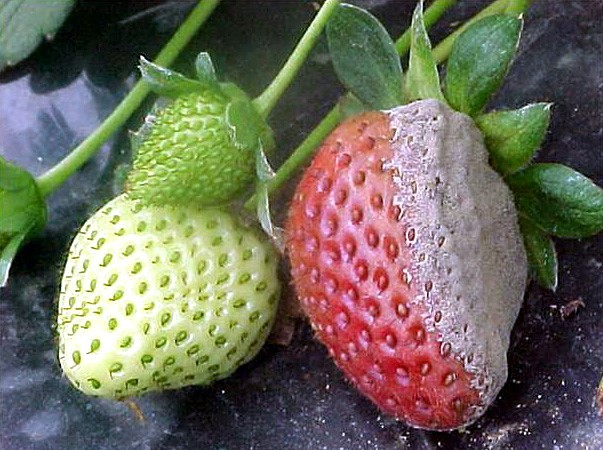Spray Guidelines to Manage Fungicide Resistance
Laura McDermott, Team Leader, Small Fruit and Vegetable Specialist
Eastern New York Commercial Horticulture
 Botrytis cinerea, the causal agent of gray mold on strawberry, on infected fruit.
Botrytis cinerea, the causal agent of gray mold on strawberry, on infected fruit.Note dusty covering of gray spores on infected fruit. Courtesy of APS image database: IW000098
Written by Dr. Cassandra Swett
Here's a strawberry spray guide that manages fungicide resistance, when your main objective is gray mold (Botrytis) protection:
Pre-bloom (crown rot protection)
Spray: Every 7-10 days
Rotating: Captan 50 WG or 80 WDG (group M)
With: Rovral 50 WG (Group 2) --this compound can only be applied once, and only pre-bloom
Early Bloom (10%) to fruit set
Spray: Every 7-10 days
Rotating: Elevate 50 WDG (group 17), CaptEvate (group M + 17), Switch 62.5 WG (group 9 + 12), Fontelis* (group 7), Scala (group 12) and Pristine WG (group 7 + 11)
With: Captan or Thiram Granuflo+ (both group M)
An example: Captan+Fontelis*, then Switch, then Captan, then Pristine, then Thiram+, then Elevate, then Captan
After fruit set:
Spray: Every 7-10 days
Rotating: Captan and Thiram+ (both group M)
With: CaptEvate (group M + 17), Elevate (group 17), or Fontelis* (group 7) -each applied only once during this interval.
Rates
For every compound, there is a range in the rate you can apply. For fungicides at risk of resistance (Switch, Pristine, Rovral, Scala), the lower rate is always recommended. For fungicides that are not at a high chance of resistance (Elevate, Fontelis*, Captan, Thiram+), the amount you apply should be adjusted, in part, based on how high disease pressure is. If it rained at least once since your last spray, and temperatures are between 65 and 75⁰ F, you will want to use the higher concentration. If, in contrast, it's been cooler than 65, warmer than 75 and / or dry, use the lower rate.
Timing
The same goes for how often you spray. We get a lot of rain this time of year, and every time it rains the fungus has a chance to infect plants. So long as it's raining about every week, plan to spray every 7-10 days.
Tips
- Control is improved when you rotate between Fontelis* and Switch and when you tank mix Fontelis with Captan.
- One of the compounds in Pristine is the same FRAC group as Fontelis*, so don't use these sequentially.
- Switch and Pristine are both highly effective, but are at high risk of resistance if they are used too often. Because of this, it is recommended that they are only used ONCE each year.
What about non-synthetic chemicals?
There is some interest in using non-synthetic chemicals for fruit rot control, as a rotation with synthetic chemicals, especially in post bloom control, and for organic management. One such compound is Regalia, a plant extract labeled for use on gray mold and anthracnose fruit rot in strawberry. Trials are lacking for strawberries, but in grape Regalia can be as effective as Pristine against Colletotrichum, and is moderately effective against Botrytis. In trials in California, disease control with Regalia is best when rotated with conventional compounds. We will be doing work on strawberry starting this year to evaluate Regalia and other bio-pesticides / biologicals, so we should have more information on this in future years.
*Fontelis is not labelled in NYS.
+Thiram Granuflo is labelled but is NOT listed in the 2015 Cornell Pest Management Guidelines for Berry Crops.
Source: Penn State Extension, Small Fruit Blog http://extension.psu.edu/plant....
This article is from the April 11, 2018 CCE ENYCHP Berry News, Click Here for the FULL NEWSLETTER

Upcoming Events
2026 Winter Cut Flower Webinar Series
January 6, 2026
The fifth annual CCE Cut Flower Webinar Series begins on January 6, 2026 and continues over 5 weeks on Tuesdays. This is a very popular series of online events you won't want to miss, with topflight speakers, a wide variety of subjects concerning growing cut flowers and plenty of interaction between speakers and attendees.
Tuesdays 1pm-3pm January 6, 2026 - February 3, 2026 (The webinar held on February 3 will run 1pm-4pm)
Cost: $60.00 for all five sessions, $20 for single sessions
Webinars will be recorded, and all the recordings will be sent to registrants for future review.
Expanding Farm Sales: Markets, Profits, and Branding Series
January 10, 2026
Looking to diversify where you sell your farm products? This four-part workshop series helps farmers explore new opportunities in direct-to-consumer, wholesale, and institutional markets. Learn how to meet buyer expectations, price for profitability, and build lasting relationships that support your business goals. Participants will strengthen marketing and communication skills, evaluate which sales channels best fit their farm, and connect with buyers, distributors, and local partners who can help expand their reach. Whether you're just starting out or ready to grow your market presence, this program will help you chart the right path for your farm's future.
Four Session Series: Saturdays from 10AM to Noon, January 10-January 31, 2026
Attend at one of three locations: Schoharie Extension Center - Cobleskill, NY; Otsego Education Center - Cooperstown, NY; Via Zoom
Pre-registration is requested! Fee: $25 Register Here
Any questions can be directed to Kelley Doolin at kmd322@cornell.edu
Pesticide Applicator Certification Exam Prep Course
January 13 - January 14, 2026
Join ENYCHP specialists for an in-depth review of topics covered on the NYS DEC pesticide applicator certification exam. This two-day virtual course includes explanation of key concepts on the core exam, test-taking tips for the core and category exam, practice questions, and Q&A with instructors. Course materials, including program recordings, practice exams, and DEC materials will be available to registrants after the program. This training is geared toward certification categories 1A (agricultural plant), 21 (field and forage), 22 (fruit), and 23 (vegetable).












































